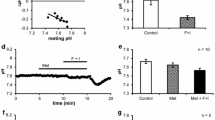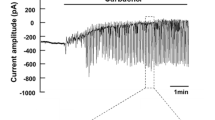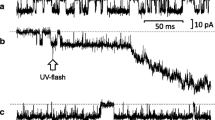Abstract
Intralobular striated ducts have been isolated from rabbit mandibular salivary glands and maintained in primary culture for up to 2 days. Such ducts were loaded with the Cl−-sensitive fluorescent dyeN-(ethoxycarbonylmethyl)-(6-methoxyquinolinium bromide) (MQAE) and intracellular Cl− concentration ([Cl−]i monitored using a fluorescence microscope. Intracellular Cl− could be rapidly and reversibly emptied from striated duct cells by replacing Cl− in the superfusing solution with NO −3 . [Cl−]i could be lowered by removal of external Na+, exposure to 10 μM amiloride or to 10 μM 4,4′-diisothiocyanatostilbene-2,2′-disulphonic acid (DIDS). Both amiloride and DIDS were able to inhibit the recovery of [Cl−]i after an initial exposure to Na+- or Cl−-free solution. The amiloride derivatives, benzamil (2 μM) and N-isobutyl-N-methylamiloride (MIBA), (10 μM) also lowered [Cl−]i by similar amounts as 10 μM amiloride. Varying external K+ concentration ([K+]o) also affected [Cl−]i. Increasing [K+]o increased [Cl−]i, but decreasing [K+]o did not decrease [Cl−]i. Instead, [Cl−]i was also increased when [K+]o was lowered below the control value. Bumetanide (0.1 mM) lowered [Cl−]i by only a small amount, while ouabain (1 mM) had no significant effect on [Cl−]i. These data are consistent with current models of electrolyte transport in salivary ducts which include Cl− channels, Na+ channels, and Na+/H+ exchangers in the apical membrane. The effects of low [K+]o can be interpreted in terms of a K+-dependent exit mechanism for Cl−.
Similar content being viewed by others
References
Augustus J, Bijman J, Os CH van (1978) Electrical resistance of rabbit submaxillary main duct: a tight epithelium with leaky cell membranes. J Membr Biol 43:203–226
Becq F, Fanjul M, Mahieu I, Berger Z, Gola M, Hollande E (1992) Anion channels in a human pancreatic cancer cell line (Capan-1) of ductal origin. Pflügers Arch 420:46–53
Bijman J (1982) Transport parameters of the main duct of the rabbit mandibular salivary gland. PhD Thesis, University of Nijmegen, The Netherlands
Bijman J, Cook DI, Os CH van (1983) Effect of amiloride on electrolyte transport parameters of the main duct of the rabbit mandibular salivary gland. Pflügers Arch 398:96–102
Bridges RJ, Worrell RT, Frizzell RA, Benos DJ (1989) Stilbene disulfonate blockade of colonic secretory Cl channels in planar lipid bilayers. Am J Physiol 256:C 902-C 912
Cabantchik ZI, Greger R (1992) Chemical probes for anion transporters of mammalian cell membranes. Am J Physiol 262:C 803-C 827
Case RM, Conigrave AD, Novak I, Young JA (1980) Electrolyte and protein secretion by the perfused rabbit mandibular gland stimulated with acetylcholine or catecholamines. J Physiol (Lond) 300:467–487
Case RM, Conigrave AD, Favaloro EJ, Novak I, Thompson CH, Young JA (1982) The role of buffer anions and protons in secretion by the rabbit mandibular salivary gland. J Physiol (Lond) 322:273–286
Cliff WH, Schoumacher RA, Frizzell RA (1992) cAMP-activated Cl channels in CFTR-transfected cystic fibrosis pancreatic epithelial cells. Am J Physiol 262:C 1154-C 1160
Dinudom A, Young JA, Cook DI (1993) Amiloride-sensitive Na+ current in the granular duct cells of mouse mandibular glands. Pflügers Arch 423:164–166
Evans RL, Lau KR, Case RM (1992) The effect of isoprenaline on intracellular Cl− concentration in isolated rabbit mandibular gland ducts. J Physiol (Lond) 446:351 P
Evans RL, Lau KR, Case RM (1993) Structural and functional characterization of striated ducts isolated from the rabbit mandibular salivary gland. Exp Physiol 78:49–64
Foskett JK (1990) [Ca2+]i modulation of Cl− content controls cell volume in single salivary acinar cells during fluid secretion. Am J Physiol 259:C 998-C 1004
Frömter E, Gebler B, Schopow K, Pockrandt-Hemstedt J (1974) Cation and anion permeability of rabbit submaxillary main duct. In: Thorn NA, Petersen OH (eds) Secretory mechanisms of exocrine glands. Munksgaard, Copenhagen, pp 469–513
Garty H, Benos DJ (1988) Characteristics and regulatory mechanisms of the amiloride-blockable Na+ channel. Physiol Rev 68:309–373
Greger R, Schlatter R, Wang F, Forrest JN (1984) Mechanism of NaCl secretion in rectal gland tubules of spiny dogfish (Squalus acanthias). III. Effect of stimulation of secretion by cyclic AMP. Pflügers Arch 411:670–675
Karniski LP, Aronson PS (1987) Anion exchange pathways for Cl− transport in rabbit renal microvillus membranes. Am J Physiol 253:F 513-F 521
Kleyman TR, Cragoe Jr EJ (1990) Cation transport probes: the amiloride series. Methods Enzymol 191:739–755
Knauf H (1972) The isolated salivary duct as a model for electrolyte transport studies. Pflügers Arch 333:82–94
Knauf H, Lübcke R, Kreutz W, Sachs G (1982) Interrelationships of ion transport in rat submaxillary duct epithelium. Am J Physiol 242:F 132-F 139
Knickelbein RG, Dobbins JW (1990) Sulfate and oxalate exchange for bicarbonate across the basolateral membrane of rabbit ileum. Am J Physiol 259:G 807-G 813
Krapf R, Berry CA, Verkman AS (1988) Estimation of intracellular chloride activity in isolated perfused rabbit proximal convoluted tubules using a fluorescent indicator. Biophys J 53:955–962
Kuo S-M, Aronson PS (1988) Oxalate transport via the sulfate/HCO3 exchanger in rabbit renal basolateral membrane vesicles. J Biol Chem 263:9710–9717
Lau KR, Howorth AJ, Case RM (1990) The effects of bumetanide, amiloride and Ba2+ on fluid and electrolyte secretion in rabbit salivary gland. J Physiol (Lond) 425:407–427
Lau KR, Evans RL, Case RM (1993) Amiloride and DIDS cause intracellular Cl− to fall in intralobular striated ducts isolated from rabbit mandibular salivary glands. J Physiol (Lond) 467:218 P
Mangos JA, Braun G, Hamann KF (1966) Micropuncture study of sodium and potassium excretion in the rat parotid saliva. Pflügers Arch 291:99–106
Marino CR, Matovcik LM, Gorelick FS, Cohn JA (1991) Localization of the cystic fibrosis transmembrane conductance regulator in pancreas and salivary glands. In: The pancreatic duct cell: physiology and pathophysiology. NIH, Baltimore, pp 13–14
Martin CJ, Young JA (1971) Electrolyte concentrations in primary and final saliva of the rat sublingual gland studied by micropuncture and catheterization techniques. Pflügers Arch 324:344–360
Martin CJ, Fromter E, Gebler B, Knauf H, Young JA (1973) The effects of carbachol on water and electrolyte fluxes and transepithelial electrical potential differences of the rabbit submaxillary main duct perfused in vitro. Pflügers Arch 341: 131–142
Matalon S, Bauer ML, Benos DJ, Kleyman TR, Lin C, Cragoe EJ Jr, O'Brodovich H (1993) Fetal lung epithelial cells contain two populations of amiloride-sensitive Na+ channels. Am J Physiol 264:L 357-L 364
Novak I, Young JA (1986) Two independent anion transport systems in rabbit mandibular salivary glands. Pflügers Arch 407:649–656
Novak I, Pedersen PS, Larsen EH (1992) Chloride and potassium conductances of cultured human sweat ducts. Pflügers Arch 422:151–158
Ram SJ, Kirk KL (1989) Cl− permeability of human sweat duct cells monitored with fluorescence-digital imaging microscopy: evidence for reduced plasma membrane Cl− permeability in cystic fibrosis. Proc Natl Acad Sci USA 86: 10 166–10 170
Reddy MM, Quinton PM (1989) Altered electrical potential profile of human reabsorptive sweat duct cells in cystic fibrosis. Am J Physiol 257:C 722-C 726
Reddy MM, Quinton PM (1989) Localization of Cl− conductance in normal and Cl− impermeability in cystic fibrosis sweat duct epithelium. Am J Physiol 257:C 727-C 735
Reddy MM, Quinton PM (1991) Intracellular potassium activity and the role of potassium in transepithelial salt transport in the human reabsorptive sweat duct. J Membr Biol 119: 199–210
Silva P, Stoff J, Field M, Fine L, Forrest JN, Epstein FH (1977) Mechanism of active chloride secretion by shark rectal gland: role of Na-K-ATPase in chloride transport. Am J Physiol 233: F 298-F 306
Slegers JFG, Moons WM, Idzerda PP, Stadhouders AM (1975) The contribution of a chloride shunt to the transmucosal potential of the rabbit submaxillary duct. J Membr Biol 25:213–236
Thaysen JH, Thorn NA, Schwartz IL (1954) Excretion of sodium, potassium, chloride and carbon dioxide in human parotid saliva. Am J Physiol 178:155–159
Tilmann M, Kunzelmann K, Frobe U, Cabantchik ZI, Lang HJ, Englert HC, Greger R (1991) Different types of blockers of the intermediate conductance outwardly rectifying chloride channel (ICOR) of epithelia. Pflügers Arch 418:556–563
Trezise AEO, Buchwald M (1991) In vivo cell-specific expression of the cystic fibrosis transmembrane conductance regulator. Nature 353:434–437
Vasseur M, Frangne R, Alvarado F (1993) Buffer-dependent pH sensitivity of the fluorescent chloride-indicator dye SPQ. Am J Physiol 264:C 27-C 31
Verkman AS, Sellers MC, Chao AC, Leung T, Ketcham R (1989) Synthesis and characterization of improved chloridesensitive fluorescent indicators for biological applications. Anal Biochem 178:355–361
Young JA, Lennep EW van (1979) Transport in salivary and salt glands. In: Giebisch G, Tosteson DC, Ussing HH (eds) Membrane transport in biology IVB. Springer, Berlin Heidelberg New York, pp 563–574
Young JA, Schogel E (1966) Micropuncture investigation of sodium and potassium excretion in rat submaxillary saliva. Pflügers Arch 291:85–98
Young JA, Cook DI, Lennep EW van, Roberts M (1987) Secretion by the major salivary glands. In: Johnson LR (ed) Physiology of the gastrointestinal tract, 2nd edn. Raven Press, New York, pp 773–815
Author information
Authors and Affiliations
Rights and permissions
About this article
Cite this article
Lau, K.R., Evans, R.L. & Case, R.M. Intracellular Cl− concentration in striated intralobular ducts from rabbit mandibular salivary glands. Pflügers Arch. 427, 24–32 (1994). https://doi.org/10.1007/BF00585938
Received:
Revised:
Accepted:
Issue Date:
DOI: https://doi.org/10.1007/BF00585938




